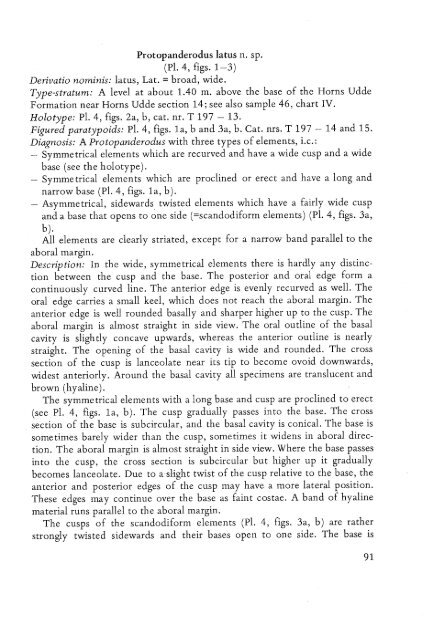UTRECHT MICROPALEONTOLOGICAL BUllETINS
UTRECHT MICROPALEONTOLOGICAL BUllETINS
UTRECHT MICROPALEONTOLOGICAL BUllETINS
Create successful ePaper yourself
Turn your PDF publications into a flip-book with our unique Google optimized e-Paper software.
Protopanderodus latus n. sp.<br />
(PI. 4, figs. 1-3)<br />
Derivatio nominis: latus, Lat. = broad, wide.<br />
Type-stratum: A level at about 1.40 m. above the base of the Horns Udde<br />
Formation near Horns Udde section 14; see also sample 46, chart IV.<br />
Holotype: PI. 4, figs. 2a, b, cat. nr. T 197 - 13.<br />
Figured paratypoids: PI. 4, figs. la, band 3a, b. Cat. nrs. T 197 - 14 and 15.<br />
Diagnosis: A Protopanderodus with three types of elements, i.e.:<br />
- Symmetrical elements which are recurved and have a wide cusp and a wide<br />
base (see the holotype).<br />
- Symmetrical elements which are proclined or erect and have a long and<br />
narrow base (PI. 4, figs. la, b).<br />
- Asymmetrical, sidewards twisted elements which have a fairly wide cusp<br />
and a base that opens to one side (=scandodiform elements) (PI. 4, figs. 3a,<br />
b).<br />
All elements are clearly striated, except for a narrow band parallel to the<br />
aboral margin.<br />
Description: In the wide, symmetrical elements there is hardly any distinction<br />
between the cusp and the base. The posterior and oral edge form a<br />
continuously curved line. The anterior edge is evenly recurved as well. The<br />
oral edge carries a small keel, which does not reach the aboral margin. The<br />
anterior edge is well rounded basally and sharper higher up to the cusp. The<br />
aboral margin is almost straight in side view. The oral outline of the basal<br />
cavity is slightly concave upwards, whereas the anterior outline is nearly<br />
straight. The opening of the basal cavity is wide and rounded. The cross<br />
section of the cusp is lanceolate near its tip to become ovoid downwards,<br />
widest anteriorly. Around the basal cavity all specimens are translucent and<br />
brown (hyaline).<br />
The symmetrical elements with a long base and cusp are proc1ined to erect<br />
(see PI. 4, figs. la, b). The cusp gradually passes into the base. The cross<br />
section of the base is subcircular , and the basal cavity is conical. The base is<br />
sometimes barely wider than the cusp, sometimes it widens in aboral direction.<br />
The aboral margin is almost straight in side view. Where the base passes<br />
into the cusp, the cross section is subcircular but higher up it gradually<br />
becomes lanceolate. Due to a slight twist of the cusp relative to the base, the<br />
anterior and posterior edges of the cusp may have a more lateral position.<br />
These edges may continue over the base as faint costae. A band of hyaline<br />
material runs parallel to the aboral margin.<br />
The cusps of the scandodiform elements (PI. 4, figs. 3a, b) are rather<br />
strongly twisted sidewards and their bases open to one side. The base is
















